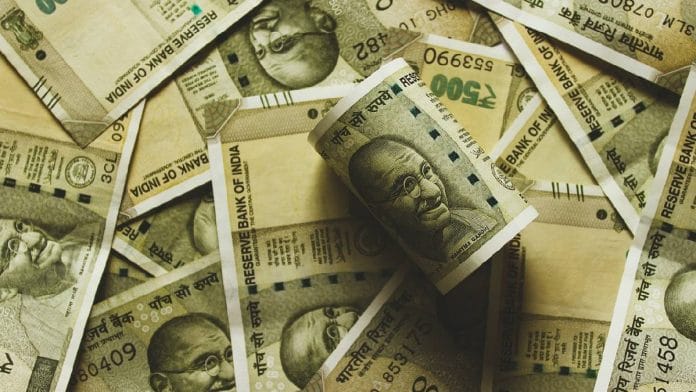New Delhi: Claims made in an Oxfam report released earlier this week about how India’s top 1 per cent of people own more than 40.6 per cent of its total wealth have made news over the last few days. A deeper reading of the report, however, reveals a few factual and conceptual issues that are worth highlighting.
The first issue with the Oxfam report, titled ‘Survival of the Richest’ and made public Monday, the first day of the World Economic Forum’s annual meeting in Davos, is that a lot of its consumption analysis is based on old data taken from the National Sample Survey Organisation’s (NSSO’s) Household Consumption of Various Goods and Services in India 2011-12.
While it is not Oxfam’s fault that we don’t have any recent consumption data from the central government, the fact that some of the data it uses is from more than a decade ago while other (GST rates) is from this year is worth noting.
Using the 2011-12 data, Oxfam estimates that the bottom 50 per cent of the population spends 6.7 per cent of income on taxes on select food and non-food items. Note that this is not expenditure on the items themselves, but on the taxes paid on the items.
The food items Oxfam has looked at are pulses, milk, cereals, edible oil, meat, dry fruits, beverages, and packaged processed food.
Of these, the GST rate on pulses is nil when sold loose and 5 per cent — the lowest slab —when packaged. GST on edible oils is also 5 per cent. Milk, cereals (when not provided free by the government), and meat are all exempt from GST.
Dry fruits and packaged food are taxed at 12 per cent and 18 per cent, respectively, but it is worth looking into how much of each of these the poor actually eat, given the high base price of these items.
The non-food items Oxfam has included in its calculations include washing powder, refrigerator, motorcycle/scooter, mobile phone, pan and tobacco, fuel and light, clothes, bedding, footwear, toiletries, crockery and utensils, air conditioner/cooler, washing machine, laptop and jewellery/ornaments.
Of these, most items in the highest slabs are not regular purchases — like two-wheelers, ACs, coolers, laptops, or jewellery — leave alone the fact that it’s highly unlikely the poor are buying these at all.
According to Oxfam itself, six out of 10 Indians live on less than Rs 262.4 per day, or Rs 95,776 per year. So, according to the report, the poor are spending 6.7 per cent of this (Rs 6,400) a year on just the taxes on dry fruits, packaged processed food, washing powder, clothes, footwear, fuel and light, and toiletries, not counting the base price of these items.
Further, the report says that “of the total taxes collected from these food and non-food items, 64.3 per cent of the total tax is coming from the bottom 50 per cent”.
If most of the items Oxfam has looked at are either not taxed, are periodic purchases, or are simply not bought by the poor, it is hard to explain how the poor are shouldering such a large burden of the tax share.
Further, GST is an ad valorem tax, which means the more expensive an item, the higher the value of the tax on it. Put simply, 28 per cent of Rs 10,000 is a lot more than 28 per cent of Rs 1,000.
Also Read: Tax India’s corporates and super-rich more. They can and will take it
Contradictory points
Then, the Oxfam report makes two seemingly contradictory points. The first is that “just 3-4 per cent” of India’s total GST collections come from the top 10 per cent of the population.
The second point the report makes is that the government should reduce the GST slabs on essential commodities and hike the taxes on luxury goods. This, it says, will lead to revenue generation that is progressive in nature and will reduce the burden on the poor.
A look at GST rates across items shows that most essentials are already taxed in the lowest slab or are exempt. Some exceptions remain, of course, and those should be rectified, but reducing the tax on the few essentials in the 12 per cent and 18 per cent slabs to 5 per cent is not going to make much of a difference in terms of easing the plight of the poor.
On the flip side, luxuries are already taxed at the highest rate of 28 per cent and many of them attract a compensation cess that takes their effective rate to the 35-43 per cent range.
If such high rates result in only 3-4 per cent of GST revenue coming from the rich, as Oxfam claims, then the problem is not with the rates, it’s with the levels of consumption.
Even if you hike the rates on luxuries to 100 per cent, this will have only a marginal impact on GST revenue, or indeed the share of revenue coming from the rich.
The overall point Oxfam is raising — that inequality in India is rising — has merit. There’s no real contention there. The problem lies with its headline-grabbing statements that seem to be taking away from a deeper discourse on the matter.
(Edited by Nida Fatima Siddiqui)
Also Read: RBI report shows banks’ health improving, but write-offs are rising too






